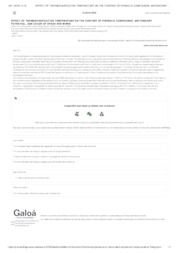Effect of thermovinification temperature on the content of phenolic compounds, antioxidant potential, and color of syrah red wines.
Effect of thermovinification temperature on the content of phenolic compounds, antioxidant potential, and color of syrah red wines.
Autoria: SILVA, I. S.; CORREA, L. C.; BARROS, A. P. A.; BIASOTO, A. C. T.
Resumo: Thermovinification is a winemaking practice that replaces traditional maceration, used to increase the phenolic compound content of red wines, and is applied to the vinification of grapes that did not reach the ideal ripeness level at the time of harvest. The objective of this study was to evaluate the influence of thermovinification temperature on the profile of phenolic compounds, antioxidant potential, and coloration of red wines. The following treatments were carried out: traditional vinification with a 7-day of maceration during the fermentation (VT); thermovinification at 55°C for 2h (TV55); thermovinification at 65°C for 2h (TV65); thermovinification at 75°C for 2h (TV75). The phenolic compounds (n=26) were quantified by HPLC-DAD-FD, total phenolics and antioxidant activity by spectrophotometric methods, and color by CIELab system. The results showed that thermovinification increased the total phenolic content of the wine and also reduced luminosity (L*), making the wine darker. However, higher temperature (75°C) promoted anthocyanin degradation, whereas wines thermovinified at 55°C showed the highest concentrations of these pigments. Thus, the redness coordinate a* was affected by the practice, decreasing as the temperature increased. Among flavonols, kaempferol-3-O-glucoside, quercetin-3-?-D-glucoside, and isorhamnetin-3-O-glucoside were higher in TV65 and TV75 wines. The yellow coordinate b* was higher in thermovinified wines. Regardless of the temperature, the content of phenolic acids decreased due to the influence of thermovinification, with the exception of caftaric acid, one of the major compounds, which was approximately 50 times higher. Stilbenes were quantified in greater quantities in TV75. For the flavan-3-ols, TV65 stood out, especially in (+)-catechin, (-)-epicatechin, procyanidin A2, and procyanidin B1. TV65 and TV75 wines also showed higher antioxidant capacity by the DPPH method. In conclusion, the use of a temperature of 65°C is recommended for thermovinification practice, due to the higher levels of bioactive compounds with antioxidant capacity that it provided to the wine.
Ano de publicação: 2023
Tipo de publicação: Resumo em anais e proceedings
Unidade: Embrapa Meio Ambiente
Palavras-chave: Bioactive compounds, Maceração, Thermomaceration, Tropical wine, Vinho
Observações
1 - Por padrão são exibidas publicações dos últimos 20 anos. Para encontrar publicações mais antigas, configure o filtro ano de publicação, colocando o ano a partir do qual você deseja encontrar publicações. O filtro está na coluna da esquerda na busca acima.
2 - Para ler algumas publicações da Embrapa (apenas as que estão em formato ePub), é necessário ter, no celular ou computador, um desses softwares gratuitos. Sistemas Android: Google Play Livros; IOS: iBooks; Windows e Linux: software Calibre.
Acesse outras publicações
Acesse a Base de Dados da Pesquisa Agropecuária (BDPA) para consultar o acervo completo das bibliotecas da Embrapa.

